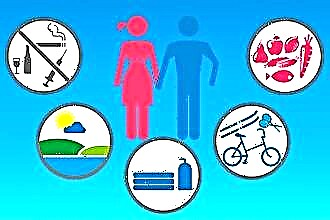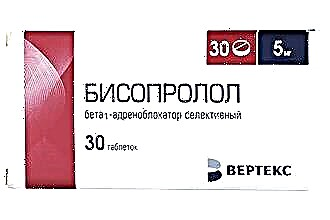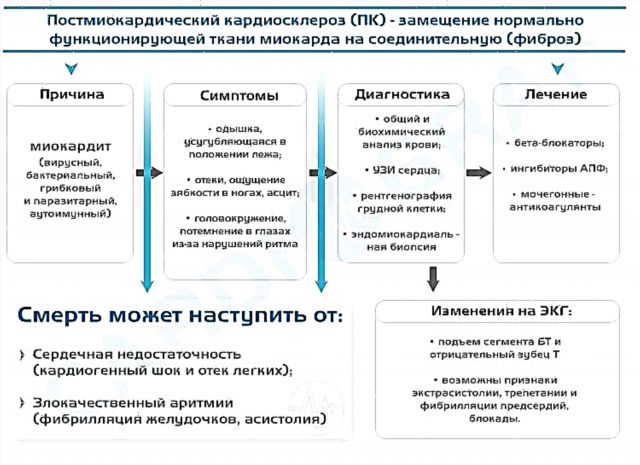Pulmonary heart disease occurs in people suffering from various pathologies of the lungs and heart. It manifests itself as frequent shortness of breath, pain, blue skin (cyanosis), rapid breathing and other symptoms. To draw up a course of treatment and accurately determine the cause of the pathology, electrocardiography (ECG), chest X-ray and ultrasound examination of the heart muscle and blood vessels are performed. After the diagnosis is made, the doctor will explain what cor pulmonale is and how to deal with it. Depending on the form of the disease and its severity, the patient may require oxygen treatment, drug therapy, folk remedies and lifestyle adjustments.
Development of the syndrome
 Cor pulmonale is a life-threatening pathological process, as it often leads to death without timely assistance. To understand what this is will help to determine the mechanism of the onset of the disease. A decrease in the vasculature in the pulmonary circulation due to damage to the outer layer of the alveoli leads to the development of cor pulmonale. They are spherical formations in the lungs that serve for gas exchange. The alveoli are braided by a huge number of capillaries, so their damage leads to impaired blood circulation.
Cor pulmonale is a life-threatening pathological process, as it often leads to death without timely assistance. To understand what this is will help to determine the mechanism of the onset of the disease. A decrease in the vasculature in the pulmonary circulation due to damage to the outer layer of the alveoli leads to the development of cor pulmonale. They are spherical formations in the lungs that serve for gas exchange. The alveoli are braided by a huge number of capillaries, so their damage leads to impaired blood circulation.
The patient will be able to feel on himself what a cor pulmonale is, if a tenth of the small vessels are damaged, since the symptoms will begin to manifest themselves clearly. Hypertrophy of the right ventricle of the heart begins with the death of 1/5 of the capillaries of the alveoli - these processes are very closely interrelated. If the blood supply decreases by more than a third, then the decompensation phase begins.
The load on the right heart ventricle increases already at an early stage of development due to an increase in pulmonary blood pressure due to the death of capillaries.
Constant overloads lead to hypertrophy of the heart tissue and the development of its failure.
The functional mechanisms arising from the development of the pathological process will help the patient understand what a cor pulmonale is:
- An increase in the volume of distilled blood in the pulmonary circulation. The death of capillaries and vasoconstriction due to high pressure cause hypoxemia (oxygen deficiency in the blood). Its lack is eliminated by activating the compensatory mechanism. The body tries to restore balance by increasing the volume of blood distilled by the heart.
- Euler-Liljestrand reflex. Oxygen deficiency causes capillary constriction. After normalization of its amount in the blood, they expand.
- Increased pulmonary blood pressure. Extinction of capillaries and severe cough, characteristic of lung diseases, lead to vasoconstriction. The patient's intrathoracic pressure increases and there is a squeezing painful sensation in the region of the heart.
- Narrowing of blood vessels due to the influence of substances produced by the body. With the development of hypoxemia, the body begins to produce special compounds (serotonin, thromboxane, endotolin, lactic acid), which contribute to the development of spasm of the vascular walls. Their effect also provokes an increase in pulmonary pressure.
- Viscosity of blood. Due to the lack of oxygen, microaggregates are produced that slow down the blood flow. The blood becomes thicker and affects the development of pulmonary hypertension.
- Infectious diseases provoke the development of cor pulmonale and aggravate the course of the pathological process. They have a negative effect due to impaired ventilation of the lungs. Against this background, pressure and oxygen deficiency increase. The gradual suppression of the work of the heart muscle provokes the development of myocardial dystrophy.
Characteristics of the disease
Focusing on the generally accepted classification, you can figure out what a cor pulmonale is. According to the rate of development, pathology is of the following forms:
- Acute cor pulmonale manifests itself with lightning speed. The clinical picture is getting worse every minute.
- Subacute cor pulmonale develops within 2 days to 2–3 weeks.
- Chronic cor pulmonale develops over the years.
Acute syndrome often occurs when blood clots build up in an artery that feeds the lungs. They are a consequence of atherosclerosis, ischemia, rheumatism and other vascular diseases. In recent years, the acute form of pathology is becoming more common.
The subacute variety is not so dangerous, but without treatment it can be fatal. The clinical picture develops gradually, so there will be time for an examination to identify the cause and eliminate it.
The chronic form of the disease develops for 2-3 years. Patients do not seek to find out what cor pulmonale is in order to get acquainted with the methods of treatment, because it does not have special manifestations at the beginning of development.
 Over time, cardiac tissue hypertrophy occurs due to a lack of oxygen in the blood. It leads to dilatation of the ventricle and atrium on the right side, that is, to their expansion. Due to the aggravation of the disease, the blood flow is disturbed, and malfunctions of the internal organs occur. Chronic hypertrophy can develop even faster due to the effects of pathologies of the bronchopulmonary system (bronchitis, pneumonia).
Over time, cardiac tissue hypertrophy occurs due to a lack of oxygen in the blood. It leads to dilatation of the ventricle and atrium on the right side, that is, to their expansion. Due to the aggravation of the disease, the blood flow is disturbed, and malfunctions of the internal organs occur. Chronic hypertrophy can develop even faster due to the effects of pathologies of the bronchopulmonary system (bronchitis, pneumonia).
A factor influencing development is no less important for a person who wants to know what a cor pulmonale is. In total, 3 etiological groups are classified:
- The vascular group consists of the vascular causes of the development of cor pulmonale.
- The bronchopulmonary category includes diseases of the lungs and bronchus.
- The thoracodiaphragmatic class includes diseases that affect the ventilation of the lungs.
To understand how to treat a pathology, it is important for a specialist to find out its stage of development:
- The preclinical stage is characterized by overstrain of the right cardiac ventricle and rare bouts of increased pulmonary blood pressure.
- The subcompensated stage is manifested by an increase in the size of the right ventricle and persistent pulmonary hypertension. There are no symptoms of circulatory failure.
- The decompensated stage is determined if, in the patient, signs of insufficiency of the functions of the heart and lungs join the symptoms of the subcompensated stage of development.
Reasons for the appearance
The reasons for the development of the disease have certain differences, depending on its form. Acute cor pulmonale is manifested due to the influence of the following factors:
- the formation of blood clots in the pulmonary artery and on its branches;
- pneumomediastinum (accumulation of air in the mediastinum);
- severe pneumonia;
- frequent attacks of bronchial asthma;
- asthmatic status.
The subacute form of the disease develops due to the following factors:
- the appearance of microscopic embolism in the pulmonary circulation;
- inflammation of the walls of the pulmonary vessels (vasculitis);
- persistent increase in blood pressure in the pulmonary artery of unknown origin (primary);
- diffuse inflammatory infiltration of the alveoli;
- the development of neoplasms in the mediastinum;
- advanced bronchial asthma;
- hyperventilation of the lungs against the background of botulism, poliomyelitis and other diseases.
The disease of the chronic course is formed under the influence of the following pathological processes:
- persistent primary increase in pulmonary artery blood pressure;
- inflammatory processes in the pulmonary artery;
- pulmonary emboli of a recurrent nature of the appearance;
- complications after amputation of a whole lung or part of it;
- obstructive pathologies of the bronchopulmonary system:
- bronchial asthma;
- pneumosclerosis;
- chronic bronchial inflammation;
- emphysema of the lungs.
- decreased lung compliance due to the development of restrictive processes;
- respiratory failure caused by pulmonary fibrosis;
- the presence of many cystic formations in the lungs;
- trauma of the chest and spinal column with deformity;
- adhesions in the pleural cavity;
- excess body weight caused by other diseases.
Symptoms
 The clinical picture of the disease differs depending on its form. Acute cor pulmonale has the following symptoms:
The clinical picture of the disease differs depending on its form. Acute cor pulmonale has the following symptoms:
- sharp chest pain;
- persistent shortness of breath;
- the development of cyanosis;
- an increase in the size of the veins in the neck;
- severe arterial hypotension;
- attacks of tachycardia (increased heart rate);
- pain in the liver;
- nausea up to vomiting.
The subacute form of the pathological process has symptoms similar to the acute type of the disease. It differs only in the speed of development.
The chronic form of the disease can manifest itself for years with symptoms of the underlying pathological process. After the onset of the decompensation phase, patients develop the following clinical picture:
- rapid pulse;
- fast fatigability with virtually complete absence of loads;
- increasing shortness of breath;
- pain in the chest, stopped by inhalation of oxygen;
- the spread of cyanosis;
- gradual swelling of the veins in the neck;
- development of edema on the legs;
- an increase in the size of the abdomen due to the accumulation of fluid in the abdominal cavity (ascites).
The clinical picture of chronic cor pulmonale actually has no direct relationship with physical activity. A painful attack cannot be removed by taking "Nitroglycerin".
Diagnostics
Diagnostics and treatment are interrelated, since without an accurate determination of the cause of cor pulmonale, it will not be possible to draw up a correct therapy regimen. The doctor may suspect the presence of a disease in a patient by conducting an examination and identifying the following external manifestations:
- vasodilation on the cheeks and conjunctiva (the appearance of blush and "rabbit eyes");

- the spread of cyanosis (blue lips, nose, ears and tongue);
- an increase in the size of the veins in the neck;
- expansion of the nail phalanges.
While listening to the heart (auscultation) with a stethoscope, the cardiologist will hear the following abnormalities:
- pronounced pathological changes in tones above the pulmonary artery;
- a variety of wheezing associated with impaired respiratory function.
- noises indicating a failure of the right valve (at the stage of decompensation).
The following changes are visible on the roentgenogram:
- swelling of the pulmonary artery;
- an increase in lymphatic vessels;
- displacement of the shadow of the heart to the right side (at the stage of decompensation).
With an ultrasound scan of the chest cavity (echocardiography), the doctor will assess the intensity and strength of the contractions of the right heart ventricle, determine the degree of dilatation and overload. During the examination, you can also notice the interventricular septum bending to the left.
The state of the respiratory function is determined on a spirograph. Focusing on the volume of inspiration, its speed, as well as the ratio of gas and oxygen, the doctor will assess the severity of pathological abnormalities.
Measurement of pulmonary pressure is required in severe cases of the acute form of the disease. Pathology is diagnosed with the following indicators:
- above 25 mm Hg. Art. in a calm state;
- above 35 mm Hg. after physical exertion.
During the examination of the patient, the doctor must determine the functional class of the pathology:
- The first class is assigned to patients in whom the symptoms of diseases of the bronchopulmonary system form the basis of the clinical picture. High pressure in the pulmonary circulation is unstable.
- The second class is characteristic of people with a combination of symptoms of bronchopulmonary diseases and respiratory failure.
- The third class is characterized by all the above sounded signs in combination with manifestations of heart failure. High pressure in the pulmonary circulation is persistent.
- The fourth grade is assigned to people in the stage of decompensation. The symptomatology is pronounced and stagnant processes develop against its background. Heart and respiratory failure at the level of 3 degrees of danger.
First aid measures
With the development of an acute variety of cor pulmonale, it is necessary to urgently call an ambulance. Before she arrives, a person should lie on the floor and not move. It is desirable that the room is well ventilated.
In a hospital setting, the patient is expected to receive thromboembolic therapy. It should be started as early as possible to increase the chances of restoring the patency of the pulmonary artery and preventing death.
Together with thromboembolic therapy, doctors can take the following measures to stabilize the patient's condition:
- artificial ventilation of the lungs;
- injection of analgesics and drugs for heart and respiratory failure;
- surgery to remove a blood clot.
Drug therapy
 The scheme of drug treatment of cor pulmonale is drawn up, focusing on the patient's condition and the main pathological process. Basically, it includes the following groups of drugs:
The scheme of drug treatment of cor pulmonale is drawn up, focusing on the patient's condition and the main pathological process. Basically, it includes the following groups of drugs:
- Broad-spectrum antibiotics. They are recommended if the patient has diseases of the bronchopulmonary system caused by a bacterial infection.
- Preparations with bronchodilatory effects, which are used to relieve attacks of bronchial asthma and obstructive bronchitis.
- The use of antiplatelet agents and anticoagulants is due to thickening of the blood and the presence of thromboembolism.
- Diuretics (diuretics) are used to treat edema and heart failure.
- Drugs with antiarrhythmic effects and cardiac glycosides are prescribed to normalize the heart in case of right ventricular failure and arrhythmias.
- Glucocorticosteroids are used if the disease has developed against the background of an autoimmune failure.
- Nitrates are used to normalize blood circulation.
- Expectorant drugs and mucolytics are used to remove sputum in bronchopulmonary diseases.
- Potassium-containing medicines serve to saturate the body with potassium during hypokalemia. It is responsible for saturating tissues with oxygen, maintaining water and acid-base balance and other important processes.
- A solution of sodium bicarbonate is administered by drip in case of severe acidosis.
Ethnoscience
Folk remedies are used as an adjunct to many therapy regimens, but not in all cases. Acute cor pulmonale requires immediate treatment, so you should immediately call an ambulance, and not engage in independent selection of funds. Subacute and chronic forms do not have such restrictions. After the examination and the appointment of the course of the main treatment, the following folk recipes are allowed:
- Infusion on calendula should be drunk at 1 tbsp. l. 3 times a day for at least 2-3 months. For cooking, you will need to pour 500 ml of alcohol with 80 g of plant flowers. Then put to infuse for 7 days.
- Garlic-lemon drink with honey take 1 tbsp. a day before bedtime. The duration of therapy is 1 month. To prepare the product, you need to chop 3 small heads of garlic and mix them with freshly squeezed juice from 3 lemons. Add 250 ml of honey to the resulting mixture and mix well.
- The collection, consisting of hawthorn, knotweed, horsetail and tricolor violets, should be consumed as a decoction 3 times a day, 100 ml for 1 month. For cooking, you will need to take 1 tbsp. mixture and pour it into a glass of boiling water. The product needs to be infused for at least 10-15 minutes.
Recommendations
There are certain recommendations that increase the chances of recovery or relief of the general condition with strict adherence. Their list:
- the use of potassium-containing products;

- the use of oxygen therapy;
- chest massage;
- breathing exercises;
- full sleep (at least 8 hours);
- avoidance of stressful situations;
- reduction of physical and mental overload;
- giving up bad habits (drinking alcohol, smoking);
- avoiding areas with poor ecology;
- reducing the amount of salt and animal fats in the diet;
- preventing exposure to allergens.
There is a narrower range of guidelines created for specific situations:
- Chronic diseases of the bronchopulmonary system require the patient to be able to perform positional drainage of the bronchi.
- In chronic obstructive pulmonary disease, it is desirable to carry out bloodletting procedures with the introduction of "Reopolyglucin".
- Severe cases of cor pulmonale will require a heart muscle or lung transplant.
As a preventive measure, it is recommended to observe the following rules:
- To identify and begin to treat pathological processes associated with the bronchopulmonary system and heart muscle in the early stages of development. Annual preventive examinations can help with this.
- Do not self-medicate and consult with your doctor about all changes in the condition.
- Try to prevent exacerbations of the pathologies of the bronchopulmonary system to prevent the development of insufficiency of the respiratory system.
- Moderately engage in physical therapy and breathing exercises.
- Follow the rules of a healthy lifestyle and follow all the recommendations of your doctor.
- To completely eliminate foci of infection when they occur in the body in order to maintain a strong immune system.
Forecast
What prognosis the doctor will give to a patient with cor pulmonale depends on the form of the pathology. With an acute variety, death can overtake a person within a matter of minutes. If it was avoided, then the condition improves within 10 days.
The subacute form of the disease leads to death in 1-2 weeks if the patient is not helped. With successful relief of the pathology, a negative prognosis remains only for further employment. It is associated with long-term treatment of the main pathological process, which led to the development of cor pulmonale.
The chronic course of the pathology is considered quite insidious because of the mild symptoms at the beginning of development. With each passing month, the chances of eliminating the consequences of pathology will be less and less. With effective treatment carried out at the initial stage of the development of the disease, the patient can live over 10 years. The therapy, started already at the stage of decompensation, prolongs life by only 2-3 years. On average, patients with a chronic form of pathology live for about 5 years. Lung transplant prolongs life by 2 or more years in 60% of patients.
Cor pulmonale is a complication of diseases of the cardiovascular and bronchopulmonary systems. It is divided into several stages along its course. The most dangerous of these can be fatal in a matter of hours. To prevent this, experts advise people who are at risk to find out what cor pulmonale is and be examined annually. If the development of a pathological process is detected, you will need to reconsider your lifestyle and follow all the doctor's instructions. Self-medication will only exacerbate the situation and increase the chances of death.





